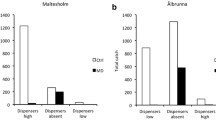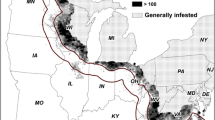Abstract
Since the beginning of the invasion of the horse chestnut leafminer, Cameraria ohridella Deschka and Dimic 1986 (Lepidoptera: Gracillariidae), into Europe over 20 years ago the damage to white flowering horse chestnut trees, Aesculus hippocastanum L (Sapindales: Hippocastanaceae) has remained extensive. This study evaluates the possible use of pheromone mating disruption as a control option against the horse chestnut leafminer. The heterogeneous distribution of ornamental trees in parks and gardens requires a different approach to evaluate pest control than in homogeneous crop fields, orchards or plantations where mating disruption is usually applied. For this reason we set up field experiments with host trees of the same age and size in field tents with a defined number of leafminers in two different densities. In the first experiment the effective quantity of newly developed C. ohridella pheromone dispensers was tested by recapturing males using traps baited with virgin females. Ninety-five percent less males were captured if three or more dispensers were positioned at a 4 m radius around the outside of an experimental tent. This set up was then used in the second experiment where male and female leafminers were released into field tents in order to assess the effect of pheromone on the reduction of leaf mining damage. Surprisingly, the pheromone dispensers were found to have no effect on the number of leaf mines at either low or high leafminer densities. Mating sites of the horse chestnut leafminer, multiple matings and distribution of pheromone dispenser are discussed as possible factors influencing the outcome in this study.



Similar content being viewed by others
References
Anderbrant O, Hedenström E, Högberg HE (2002) Pheromone mating disruption of the pine sawfly Neodiprion sertifer: is the size of the treated area important? Bull IOBC/WPRS 25(9):1–7
Carde RT, Minks AK (1995) Control of moth pests by mating disruption: successes and constraints. Annu Rev Entomol 40:559–585. doi:10.1146/annurev.en.40.010195.003015
Carpenter J, Sparks A, Gueldner R (1982) Effects of moth population density and pheromone concentration on mating disruption of the corn earworm in large screened cages. J Econ Entomol 75:333–336
Charmillot P, Pasquier D (2000) Mating disruption to control grape moths: success and failure. Bull IOBC/WPRS 23(10):145–147
Deschka G, Dimic N (1986) Cameraria ohridella sp.n. (LEP., LITHOCOLLETIDAE) aus Mazedonien, Jugoslawien. Acta Entomol Jugosl 22:11–23
Feldhege M, Eichhorn KW, Louis F (1993) Mating disruption of the European grapevine moth Lobesia botrana Schiff. (Lepidoptera: Tortricidae). Investigations on the temporal and spatial distribution of populations. Bull Oilb/Srop 16(10):90–92
Freise J (2001) Untersuchungen zur Biologie und Ökologie der Roßkastanien-Miniermotte (Cameraria ohridella Desch. & Dim.1086) (Lepidoptera: Gracillariidae). PhD Thesis, Technische Universität München, Germany
Gilbert M, Gregoire JC (2003) Visual, semi-quantitative assessments allow accurate estimates of leafminer population densities: an example comparing image processing and visual evaluation of damage by the horse chestnut leafminer Cameraria ohridella (Lep., Gracillariidae). J Appl Entomol 127:354–359. doi:10.1046/j.1439-0418.2003.00757.x
Gilbert M, Gregoire JC, Freise JF, Heitland W (2004) Long-distance dispersal and human population density allow the prediction of invasive patterns in the horse chestnut leafminer Cameraria ohridella. J Anim Ecol 73:459–468. doi:10.1111/j.0021-8790.2004.00820.x
Gilbert M, Svatos A, Lehmann M, Bacher S (2003) Spatial patterns and infestation processes in the horse chestnut leafminer Cameraria ohridella: a tale of two cities. Entomol Exp Appl 107:25–37. doi:10.1046/j.1570-7458.2003.00038.x
Girardoz S, Kenis M, Quicke D (2006) Recruitment of native parasitoids by an exotic leaf miner, Cameraria ohridella: host-parasitoid synchronization and influence of the environment. Agr For Ent 8:49–56. doi:10.1111/j.1461-9555.2006.00281.x
Girardoz S, Quicke D, Kenis M (2007) Factors favouring the development and maintenance of outbreaks in an invasive leaf miner Cameraria ohridella (Lepidoptera: Gracillariidae): a life table study. Agric For Entomol 9:141–158. doi:10.1111/j.1461-9563.2007.00327.x
Gordon D, Zahavi T, Anshelevich L, Harel M, Ovadia S, Dunkelblum E, Harari A (2005) Mating disruption of Lobesia botrana (Lepidoptera: Tortricidae): effect of pheromone formulations and concentrations. J Econ Entomol 98:135–142
Grabenweger G (2001) Effects of dry leaves removal on Cameraria ohridella Deschka & Dimic (Lepidoptera, Gracillariidae) and its parasitoids. Mitt Deutsch Gesell Allg Angew Ent 13:141–143
Grabenweger G, Kehrli P, Schlick-Steiner B, Steiner F, Stolz M, Bacher S (2005) Predator complex of the horse chestnut leafminer Cameraria ohridella: identification and impact assessment. J Appl Entomol 129:353–362. doi:10.1111/j.1439-0418.2005.00973.x
Heitland W, Freise J, Sturm A, Lenz N (2005) Die Rosskastanien-Miniermotte Cameraria ohridella DESCHKA & DIMIC, 1986 (Lepidoptera, Gracillariidae): Gründe ihres Erfolgs als Blattschädling an der weißblühenden Gewöhnlichen Rosskastanie Aesculus hippocastanum (Hippocastanaceae) und ihre Möglichkeiten zur Bekämpfung. Entomologie heute 17:157–172
Heitland W, Freise JF (2003) The EU-project CONTROCAM (“Control of Cameraria”). Nachbl Deutsch Pflschd 55:205–208
Heitland W, Kopelke JP, Freise J (2003) Die Roßkastanien-Miniermotte - 19 Jahre Forschung und noch keine Loesung in Sicht. Natur Mus 133:221–231
Hillier N, Dixon P, Larson D (2004) Trap captures of male Grapholita libertina (Lepidoptera: Tortricidae) moths: relationship to larval numbers and damage in wild lingonberry. Environ Entomol 33:405–417
Howse PE, Stevens IDR, Jones OT (1998) Insect pheromones and their use in Pest Management. Chapman & Hall, London
Kalinová B, Svatos A, Kindl J, Hovorka O, Hrdý I, Kuldová J, Hoskovec M (2003) Sex pheromone of horse-chestnut leafminer Cameraria ohridella and its use in a pheromone-based monitoring system. J Chem Ecol 29:387–404
Kehat M, Anshelevich L, Harel M, Dunkelblum E (1995) Control of the codling moth (Cydia pomonella) in apple and pear orchards in Israel by mating disruption. Phytoparasitica 23:285–296
Kehrli P, Bacher S (2004) How to safely compost Cameraria ohridella-infested horse chestnut leaf litter on private compost heaps. J Appl Entomol 128:707–709. doi:10.1111/j.1439-0418.2004.00915.x
Kenis M, Avtzis N, Freise J, Girardoz S, Grabenweger G, Heitland W, Lakatos F, Lopez Vaamonde C, Svatos A, Tomov R (2005) Finding the area of origin of the horse-chestnut leaf miner: a challenge.In: Kamata N, Liebhold AM (eds) Proceedings: IUFRO Meeting on forest insect population dynamics and host influence. 14–19 September 2003, Kanazawa, Japan
Klug T, Meyhöfer R, Kreye M, Hommes M (2008) Native parasitoids and their potential to control the invasive leafminer Cameraria ohridella DESCH. & DIM. (Lep.: Gracillariidae). Bull Entmol Res. doi:10.1017/S0007485308005695
Kühnel-Muhle EM (2006) Untersuchungen zum Paarungsverhalten und zum Einsatz von Sexualpheromonen zur Bekämpfung der Rosskastanien-Miniermotte, Cameraria ohridella DESCHKA & DIMIC 1986 (Lepidoptera, Gracillariidae). Diploma thesis, Leibnitz University Hannover, Germany
Maini S, Burgio G (1999) Ostrinia nubilalis (Hb.) (Lep., Pyralidae) on sweet corn: relationship between adults caught in multibaited traps and ear damages. J Appl Entomol 123:179–185. doi:10.1046/j.1439-0418.1999.00331.x
SAS Institute Inc. (2002) SAS for Windows 9.1. Cary, NC, USA
Schmitz V, Roehrich R, Stockel J (1995) Disruption mechanisms of pheromone communication in the European grape moth Lobesia botrana Den. & Schiff. (Lep., Tortricidae) II. Influence of the population density and the distance between insects for males to detect the females in atmosphere impregnated by pheromone. J Appl Entomol 119:303–308
Simova-Tosic D, Filev S (1985) Contribution to the horse chestnut miner. Zastita bilja 36:235–239
Skuhravy V (1998) On the leaf mining moth Cameraria obridella Desch. & Dim. (Lep., Lithocolletidae) attacking Aesculus hippocastanum L. in the Czech Republic. Anz Schaedl Pflanzsch Umweltsch 71:81–84
Svatos A, Kalinova B, Hoskovec M, Kindl J, Hovorka O, Hrdy I (1999a) Identification of a new lepidopteran sex pheromone in picogram quantities using an antennal biodetector: (8E, 10Z)-tetradeca-8, 10-dienal from Cameraria ohridella. Tetrahedron Lett 40:7011–7014. doi:10.1016/S0040-4039(99)01426-4
Svatos A, Kalinova B, Hoskovec M, Kindl J, Hrdy I (1999b) Chemical communication in horse-chestnut leafminer: Cameraria ohridella Deschka & Dimic. Plant Prot Sci 35:10–13
Systat Software Inc. (2004) SigmaStat Software for Windows 3.11. San Jose, CA, USA
Szocs G, Otvos IS, Schiller AJ, Bergmann J, Francke W (2006) Cameraria gaultheriella and C. lobatiella attracted in Canada to (E, Z)-8, 10-tetradecadienal, the sex pheromone of the European C. ohridella. Can Entomol 138:263–268
Thalmann C, Freise J, Heitland W, Bacher S (2003) Effects of defoliation by horse chestnut leafminer (Cameraria ohridella) on reproduction in Aesculus hippocastanum. Trees Struct Funct 17:383–388
Vickers RA, Thwaite WG, Williams DG, Nicholas AH (1998) Control of codling moth in small plots by mating disruption: alone and with limited insecticide. Entomol Exp Appl 86:229–239. doi:10.1023/A:1003128417245
Webb RE, Leonhardt BA, Plimmer JR, Tatman KM, Boyd VK, Cohen DL, Schwalbe CP, Douglass LW (1990) Effect of racemic disparlure released from grids of plastic ropes on mating success of gypsy moth (Lepidoptera: Lymantriidae) as influenced by dose and by population density. J Econ Entomol 83:910–916
Welter S, Pickel C, Millar J, Cave F, Steenwyk R, Dunley J (2005) Pheromone mating disruption offers selective management options for key pests. Calif Agric 59:16–22
Acknowledgments
We are greatly indebted to Prof. Uwe Koch for sharing his profound knowledge of pheromones and for his advice during the course of this study. Dr. Blanka Kalinova provided an extensive review and valuable comments on an earlier version of the manuscript. Dr. Thomas Klug and Dr. Haike Ruhnke contributed with fruitful discussions and helped with extensive field work. We are grateful to our technicians Kirsten Strauß, Michaela Erhard, Antje Wiemann and Sabine Schamlott for insect rearing, data collection and data entry. We thank three anonymous reviewers for their input. This work was carried out under the project title “Biotechnical methods to control the horse chestnut leafminer in public greens” and was funded by the German Federal Ministry of Education & Research, Grant No. 0313131.
Author information
Authors and Affiliations
Corresponding author
Additional information
Communicated by S. Bacher.
Rights and permissions
About this article
Cite this article
Siekmann, G., Meyhöfer, R. & Hommes, M. Testing mating disruption of the horse chestnut leafminer Cameraria ohridella (Lepidoptera: Gracillariidae) in field tents. J Pest Sci 82, 129–136 (2009). https://doi.org/10.1007/s10340-008-0231-z
Received:
Revised:
Accepted:
Published:
Issue Date:
DOI: https://doi.org/10.1007/s10340-008-0231-z




